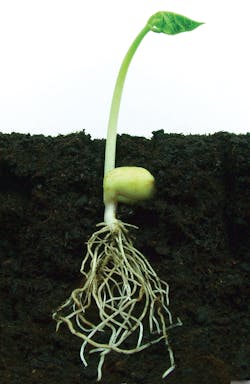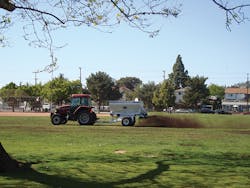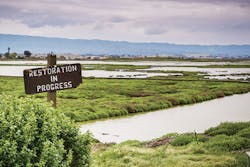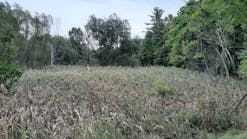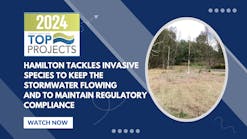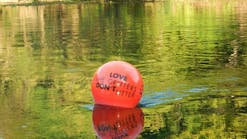Building Strong Roots from Soil and Seed
Stress Reduction
According to the manufacturer, Ecologel, Hydretain’s primary mechanism of action is to bind to living plant roots after being applied to the soil to serve as a capturing agent for evaporative moisture as it leaves the soil. Acting as a humectant by capturing moisture vapor, which plants can’t use, and collecting it into usable liquid droplets that plants can use, Hydretain gives plants access to significant amounts of moisture that would otherwise have been lost to the atmosphere. This process sustains plants between rainfall and irrigation cycles, ensuring they remain clear of drought stresses and die-off. Kramer says that in doing so, the plant exhibits fewer signs of requiring water, thereby allowing the caretaker to use less water to keep the plant healthy. According to the manufacturer, the product can reduce irrigation requirements by 35 to 50% and lasts for up to three months in the soil, after which it is broken down via microbial action into trace nutrients that can then be consumed by the plant.
Kramer says Lawn Doctor of Long Island markets a branded service called Hydroguard that uses Hydretain to enhance plant survival and vitality by retaining moisture in the root zone. But Kramer has found Hydretain helpful as well in getting seeds off to a good start. He has begun including an application of Hydretain as a free benefit bundled in his company’s lawn seeding services. “We realized that when we put this down there is a lot less damage to the lawn in the hot summer months and as a result, the lawns are much more sustainable and we don’t have to go back and fix as many. From a cost standpoint, it saves us labor and seeds and other materials. From a business perspective, it’s cheaper to give this away with seeding than to go back and fix the lawn.”
Ecologel’s Hydretain is marketed under the names LESCO Moisture Manager, available from SiteOne Landscape Supply; Hydretain ES Plus; and H3O Plus. It is available in granular or liquid applications. “We refer to it as a hygroscopic humectant technology,” says Rick Irwin, president of Ecologel. “When you’re dealing with seed germination or looking at soil moisture beyond just getting moisture to penetrate and move laterally, the hygroscopic humectant is going to grab subsurface moisture before it’s lost to evaporation and hold it down where it can be effective in effecting seed germination and eventually providing moisture to a plant in cases where a plant would not have moisture otherwise.”
“A plant can’t take vapor and use it in the root system. We convert that vapor back into droplets,” says Irwin. Formulated primarily from extracts of plant material, Irwin says, the EPA has given Hydretain a 93% bio-based rating. It’s formulated from “food-grade materials,” Irwin says; “things that are made to keep toothpaste soft, gum pliable, and used in baking breads to keep them from drying out in the oven.”
Irwin explains that the granulated version contains one gallon of liquid Hydretain in each 40-pound bag. The advantage of using the granular application on an already vegetated area is that watering gets the Hydretain right down to the root zone where it’s needed, Irwin says.
However, he says Hydretain in its original liquid application can be readily spread during hydroseeding as well. “It goes right in the tank with the hydroseeding and it’s already in contact with all of the seed and all of the mulch, so it is right there in contact with the material where it needs to be. It’s one of the most perfect applications for it,” says Irwin.
The Good Seed
When environmental conditions haven’t gone so poorly that it becomes necessary to rebuild the soil from the ground up, choosing the right seed for the right spot can provide the critical key to establishing good growth, healthy vegetation, and improved erosion control.
Susan Kenzle, landscape architect for the City of Austin Watershed Protection Department (WPD) says, “Our weather patterns are unique in their extremes. We have really long dry periods and hot periods and we also tend to have really frequent flooding, so plants we would use need to be adapted to that regime.” Her department is involved with a range of stream restoration projects with erosion control and water quality improvement as primary objectives.
“We spend a lot of time developing the seed mixes and tweaking them to get the best of both worlds; to get seeds that germinate quickly and provide quick cover, with the idea that over time we are going to want some really deep-rooted grasses that are going to do long-term stabilization on their own. We know in Texas the ones that will do a lot of that might not germinate right away. Thinking about it in a successional way, we provide that in a single seeding.” Kenzle adds, “Often, we put in container plants to kind of jump-start the process and to help in those areas that are particularly vulnerable where we need something with roots right away.”
Expectations
Darcy Nuffer, a colleague of Kenzle and fellow landscape architect with the Austin WPD, agrees. She says it is important to know what can be expected from the selected seeds. “One of the species that will come up pretty dependably in all different seasons here in Texas is green sprangletop, so we use that in a lot of our seed mixes. It’s a native grass. We know that it’s going to germinate and it’s going to provide some quick cover.” She says the longer-term stabilizing plants that are “sometimes added to the mix or that are sometimes container-grown would be eastern gamma grass or switchgrass or bushy bluestem.”
Although Kenzle says WPD doesn’t adhere to a cover crop philosophy for promoting nitrogen-fixing, she says the seed mixes she prefers always include some nitrogen-fixing plants. She says for a recent project in Eastwoods Park, focused on restoring a stream in the park and protecting several heritage trees that were threatened by erosion, the seeds that were supplied by Native American Seed included “some good native seeds for Texas like bluebonnet, partridge pea, prairie clover, [and] Illinois bundle flower.” Describing their role in the mix, she says, “Those are all colonizing plants that come up starting from that first season. They do a lot of the nitrogen-fixing from seed for us. The nitrogen fixers I mentioned come up pretty reliably from seed, so it’s economical to use them as part of the seed mix.”
Kenzle prefers seeds specifically from Texas. However, she says, “There is a lot of regional variability, so even if it says it’s from Texas that doesn’t narrow it down that much.” To more accurately pinpoint the origin of seeds selected, she says the WPD “specifications discuss the radius from Austin from which the seed should originate,” and when the order arrives, it carries a submittal tag, indicating for each seed where it was grown or harvested. “It’s pretty specifically Texas seed that we get; we’re not getting stuff from Oregon, stuff that wouldn’t do well,” confirms Nuffer. “Some of the plants we use are not available in seeds, such as a lot of the sedges that are really valuable for stream restoration, so we have to get those by container,” adds Kenzle.
On another WPD project aimed at restoring the natural flow to 800 linear feet of a stream in J.J. Seabrook Park, Nuffer says the WPD combined its efforts with Public Works and the Parks Departments to remove a lane of road that once ran to the old airport and convert it to passive recreation uses. According to Nuffer, removing this swath of pavement would reduce pollutant runoff from the impervious cover into the creek. “We also worked with the Parks Department to build a trail that runs around the entire greenbelt so people had a place to walk and enjoy the rehabilitated stream. We closed off one of the lanes running up to the airport and made that part of the bicycle lanes,” she says.
“Because the soil was pretty nice and wasn’t the product of homebuilding where they brought in soil, we stockpiled it on site during construction and then we put it back in place and replanted it. We mixed in a little compost to improve the organics content, but we didn’t bring in any imported soil for the stream project.
“I wanted a regime that went from moist right near the creek to an upland drier situation. I gave Native American Seed the species mix that I wanted and they got it duplicated,” says Nuffer.
A Knock on the Wall
When one coastal New England family began thinking of putting their home on the market, they had to face up to some fears of their own. The owners of an otherwise desirable property were confronted with the rather unsettling scenario of things going bump in the night or day. They needed to find a way to stop the noises and keep them from coming back. Taking the picture as a whole, the cause was easily determined. The house had been built on a lot that had been carved out of a steep slope. Jack Eaton, project supervisor at Certified Erosion Control explains the slope was supported at its base by a retaining wall several feet tall. Eaton says, “This slope was directly behind the house; there were only five or six feet between the slope, the wall, and the house.”
The top of that slope had begun eroding. “Rocks were actually falling from the slope and hitting the house.” Eaton describes the stones that had tumbled into the wall as “anything from the size of a fist to maybe a foot across.” The homeowners, he says, “were afraid they’d never be able to sell their house as long as that was going on.”
By the time he was called in to evaluate the situation, the homeowners had gathered a number of opinions on what to do. The top recommendation had been to go higher with the retaining wall. Eaton notes that his firm, Certified Erosion Control, has a great deal of experience with steep, “difficult slope stabilization and deep terrain slope stabilization projects.” According to Eaton, the owners had determined that raising the retention wall even higher and reshaping the slope “was not within their budget at all.”
“The slope behind the house is very steep—on the order of one to one. They were kind of stumped,” says Eaton. He says he takes a hands-on approach to the erosion control projects in his portfolio. “I am involved from concept to completion, deciding what we’re going to use, how we’re going to do it, right through to its completion.”
The house on the hill was a tough one. “We couldn’t re-contour the slope because it was adjacent to a property that did not provide access and there was not any way to get equipment to it,” he says.
After doing some work by hand to contour the slope, Eaton says the solution turned out to be “a dual application.” It involved stabilizing and re-vegetating the barren clay facing of the slope. “We were looking at adding organics and some nutrients to it and getting some growth on it.” Eaton deployed Filtrexx compost filter socks to stabilize the bottom of the slope, but he said “as the slope got steeper we weren’t comfortable doing that anymore. So we used products called Enkamat and Flexterra which are both Profile products.”
“It stabilized the slope but didn’t get any vegetation. I knew that we had very little organics up there. So we came over it with a second application, with Profile’s ProGanics product and Biosol.
“The ProGanics and the Biosol are both high concentration slow release organics,” notes Eaton. “I had good results with Biosol in the past so that’s why we chose those two products.” Eaton describes Biosol as an organic fertilizer that is very stable and slow-release, so it provides an even fertilization throughout the season. “If we used a traditional non-organic fertilizer we’d be adding it throughout the season and it would spike and die and spike and die. This product gives us good organics and a steady source of nitrogen and phosphorus.”
Ease of use was another factor in favor of Biosol, he said. “It can be applied through any traditional fertilizing equipment. I’ve done it through spreaders; I’ve done it through hydroseeders. It’s pretty adaptable in that regard to any equipment you might have on site.”
Eaton seeded the hill using New England Wetlands Plants’ roadside mix, a cool-season traditional conservation grasses mix, which was then over-seeded with a native roadside mix. With only one access point to the property, crews applied both the seeding and the soil-enhancing Biosol with blower trucks and a Finn 120 hydroseeder.
The work began in mid-spring. “It was a very optimum time to do it and we got very good results. I would have been comfortable doing it at any time during the growing season with the types of cool-season grasses we were using. I wasn’t looking for any product that would take a long time to germinate. And within two to three weeks I had a fully vegetated slope,” says Eaton.
Growing on Poor Soil
“One of the things I can do with Biosol is to take a moderate to poor soil and grow on it without adding additional loam to it,” says Eaton.
“In some cases, there would be cost savings if I could take a marginal soil and get the results I want without adding additional loam, and that would be where the advantages are.” In his area of operations in New England, he says, “a lot of the soils we’re working with have a tendency to be marginal soils.”
Visiting the site two years later, he says, “The whole wall is sustainable. We are going to do some additional work on the slope this year but the slope is naturalizing itself. The original work is all holding up very well. I’m a very big believer in the use of organics and organic soil amendments on job sites. I think it’s well worth the money spent,” he adds.
With the slope stabilized and the restless stones no longer scaring off buyers, the house was sold, and the family that once lived in the house at the bottom of the hill is no longer haunted by the nightmare of erosion.
Panic Mode
When officials with a Department of Defense facility in New York got word that an official delegation including the Vice President of the United States would be arriving in mid-August, they took steps to spruce things up. As with any proud host expecting a visit from out of town guests, part of getting things in order included mowing the lawn. However, according to Ted Kramer, president and owner of Lawn Doctor of Long Island, that simple action set off a major crisis.
“They stripped the lawn,” says Kramer. “The landscaper mowed the lawn on a 95-degree day. After that, the grass blades turn so brittle from the heat that they snap in half and the whole lawn turns brown within 12 hours of being mowed. You could see the mower tracks going over it. Typically when that happens you are done. The lawn is not going to recover from that. You have to wait and reseed it in September.”
However, waiting until the end of the season to replant was out of the question. “They had dignitaries coming 12 days later. They were in a panic mode.” But Kramer had the solution; he had been testing the capabilities of Hydretain by Ecologel and had placed the product on his roster of lawn care supplements. “We put this stuff down. They watered it three times and the lawn was completely green, like sod, seven days later, without reseeding. It’s a game-changer.”
Taking Stock in Compost
In a natural situation, plants and nature do the work of improving the soil’s capacity to sustain vegetation. But when nature has been disturbed, it can take a bit of imagination and experimentation to get things back on track.
“We have all these micro climates here in California, so we have quite a variety of seed mixes that we use,” says Scott Dowlan, senior landscape Architect for Caltrans District 5. However, he believes that in addition to having the right seeds for the job, it is critical to make sure the soil where they land is as hospitable as possible. He believes compost, in vast quantities, provides one of the best tools for doing just that.
According to Dowlan, several years ago the general practice used by Caltrans to restore vegetation to a disturbed area had been to apply hydroseeding on the bare soil. “We had very mixed results,” he says. “On Caltrans projects, the quicker we’re able to stabilize the slope, the less erosion we have, the less cleanup and maintenance we have to do.” But he says germination and growth were not always reliable and erosion was often the result. “In severe cases, we had to go regrade slopes where we had failures,” he says.
Dowlan says around 10 years ago, Caltrans began experimenting with compost on a large scale, applying it to slopes in preparation for seeding.
“We found that in all instances compost just promotes the establishment of native vegetation way better than not using compost. It really changed that dynamic and results in a much more consistent vegetative cover.”
While he says it is possible to get vegetation established without compost, that requires a different kind of investment and often lots of water, a resource not available on the scale needed for a highway project. “You might look at residential or commercial projects, and they’re applying the hydroseed to bare ground and they’re getting much better coverage not using compost, but the difference is that they are not required to use a native mix. They might be using European annuals that are typical to California but are not native to California, so they tend to establish better in bare soils.”
What Seeds Like
Additionally, he says, “A lot of times you see them using irrigation. With our large projects, the amount of water that would be needed to irrigate—and the fact that California at any given time is in a drought—means we’re looking at alternatives to irrigating slopes to establish vegetation.” That’s where compost comes in, he says. “Compost is the perfect growing medium. Not only does it have the nutrients and nitrogen, [but] it also has that high water-holding capacity, which means it’s a moist growing medium to germinate seeds and that’s what seeds like.”
Finally, he notes, “The other benefit is [that] it’s material that would otherwise be going into a landfill—we’re diverting it for beneficial use onto our roadsides to build healthy soils and protect water quality.”
Caltrans has a standard specification that identifies the compost requirements, including particle size, the acceptable level of physical contaminants, nutrient level, moisture content, and nitrogen and pathogen levels. Caltrans further requires that contractors only get compost from producers that are Seal of Testing Assurance (STA) certified by the US Composting Council. The STA is a compost testing, labeling, and information disclosure program designed to provide the information needed to get the maximum benefit from the use of compost.
Dowlan said Caltrans’ specification allows for use of compost from a range of feedstocks including green waste, food waste, biosolids and manure, or any combination of these feedstocks. “It’s pretty broad, but because we have the STA Certification and all the other requirements, we know we are getting good products.”
The compost nonetheless, varies in physical properties based on the feedstock that is used, Dowlan explains. “If we have compost that is made from greenwaste and biosolids, it’s going to be a much finer material. If we have one made solely from greenwaste, it will be more woody.”
Caltrans characterizes its compost by three categories, not based on feedstock but on particle size, which they designate as fine, medium, and coarse. The reason for this characterization is simple; different sized particles are used for different jobs on a project site. As Dowlan explains, fine compost is sometimes used as soil amendment worked into a depth of 4 to 8 inches. It is also used for container planting and in wetlands restoration planting where it is incorporated for stormwater treatment.
Medium compost is used for topical applications as a blanket. “The woody aggregated particle size provides better surface stabilization and protects the soils against raindrop splash, supplying enough fines to establish vegetation but enough diversity in particle size to protect against erosion,” says Dowlan.
On individual projects, Dowlan says he also uses medium grade compost to build the compost berms used to slow flow on a slope. These berms, he says, may or may not be reinforced with fiber netting. Often, he says, “It’s a one-step application. When the contractor is applying the blanket of compost on a slope using a pneumatic blower, they can at the same time bulk up linear berms or mounds of compost as sediment barriers using the same material. It’s amazing how effective that is in interrupting the sheet flow of water on the slope and how it causes the sediment to drop out.”
To round out the Caltrans compost arsenal, Dowlan says, the coarse material performs a specialized though important task. “Primarily, we are using the coarse material in the socks only,” which are likely to be applied to reinforce critical areas of a slope.
Smothering Weeds With Goodness
On projects that involve invasive plant management, using compost and hydroseeding with natives can help reduce the need to use herbicides, Dowlan says.
“We found that the way compost works, because it releases its nutrients and nitrogen slowly, it really promotes native vegetation growth and produces thick stands of vegetation,” says Dowlan. By contrast, he says that invasive species “like degraded and exposed sites.” He explains: “When you use pesticides you kill everything, and so what comes up again are the invasives. It becomes a vicious cycle, and all you do is end up dumping more and more pesticides without changing the biological dynamic on the site.” Compost, he says, delivers “a much better outcome as far as mitigation planting quantities because we’re not having to fight with the invasives. By using compost, whether topical or incorporated, we were changing the biological dynamic in the field and the natives we’re establishing and basically choking out the invasives.”
Dowlan believes compost can be the key to promoting stable, healthy soil. “The great thing about compost is [that] it’s really just the kickstarter. Once you get the vegetation, you’re using vegetation and the root system to promote infiltration. The roots are getting down through the compost into the native soil and all those roots are infiltrating water and through the biological system of plant evolution from germination to death. It becomes mother nature’s natural system to building healthy soil. Compost is the kickstarter to get that generated. You get the microorganisms that are associated with living soil.We’re building living systems. With compost, we’re starting off with a healthy soil on the surface and then that living system starts to take over and it develops on its own.”
